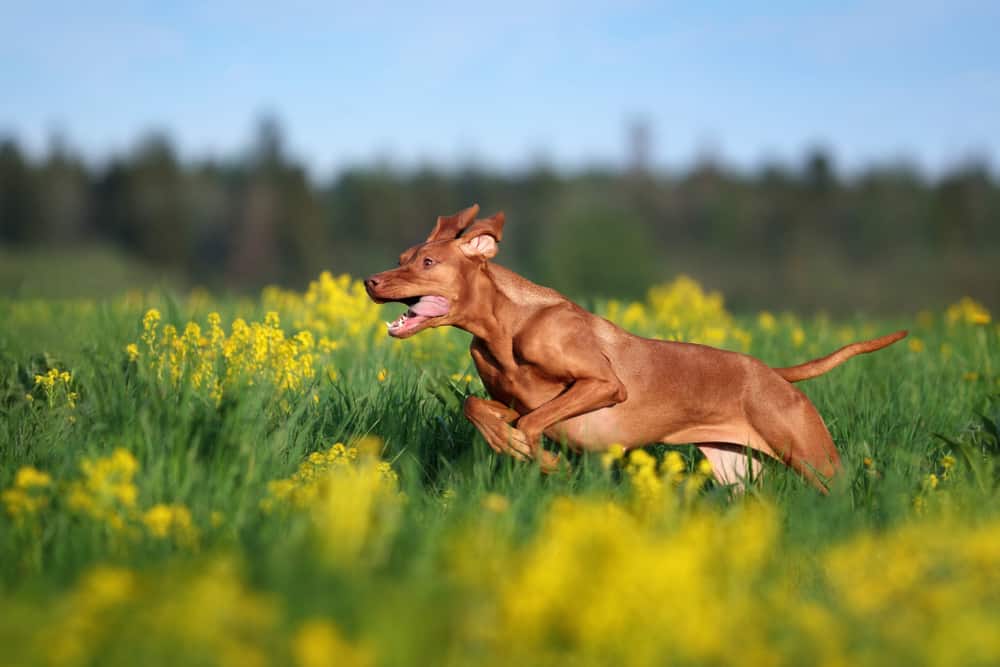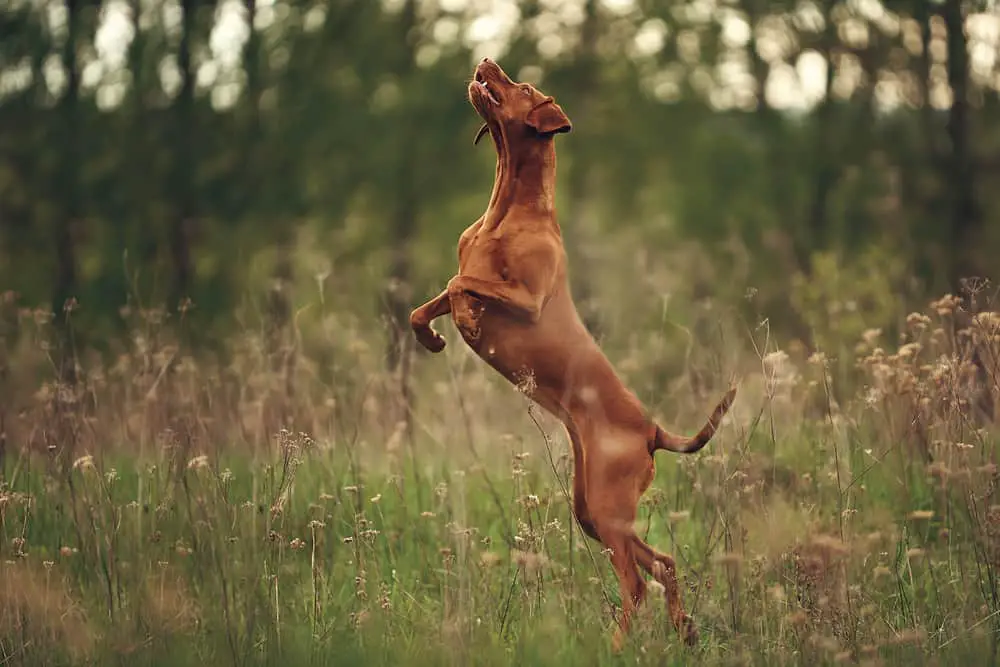I’ve done a ton of research and ultimately decided to get a Hungarian Vizsla because they are self-cleaners and low shedders. However, recently I’ve discovered that my carpets and furniture are covered in short, fine hair. Is this normal? Why is my Vizsla shedding so much?
Hungarian Vizslas are light to moderate shedders. Puppies shed very little, and adults shed all year round. Shedding increases somewhat during springtime, but excessive shedding at any other time of the year is usually a sign of environmental factors, health issues, or medical conditions.
It’s not normal or healthy for your Vizsla if he sheds too much. So, how much is too much, and what should you do about it?
When Is My Vizsla’s Shedding Normal?
Before you decide whether your Vizsla sheds more than he should, you first need to be familiar with this breed’s coat and normal shedding cycle.
The Hungarian Vizsla has a short, dense, and smooth coat, and the shedding of this copper-brown coat in adult dogs varies from light to moderate all year long while puppies shed very little.
Dogs are either single-coated or double-coated; Vizslas are single-coated, which means they have no undercoat that needs to be shed twice a year. Therefore, they shed much less than their double-coated counterparts.
This shedding is not seasonal, as with many other dogs. However, although Vizslas shed all year round, shedding does become somewhat heavier in spring when they lose excess hair from winter. They replace their thicker winter coat for a new shorter and lighter summer one.
According to Roy Cruzen, a Doctor of Veterinary Medicine from Phoenix, what is regarded as ‘normal’ shedding depends greatly on a dog’s breed, anatomy, and genetics. Ideally, you should find out about your four-legged friend’s baseline shedding as soon as or even before you bring them home.
If you find a significant change in your Vizsla’s coat and normal shedding cycle, it is usually an indication of environmental factors, health issues, or medical conditions.
What Can Cause Excessive Shedding In Vizslas?
All dogs shed whether light, moderate, or excessive. The Vizsla is no different, so if you find your loyal companion shedding more than usual, it might be due to various environmental factors, health issues, or medical conditions. Let’s have a closer look:
3 Environmental Factors Why Your Vizsla Might Shed Too Much
Vizslas are sensitive and affectionate creatures, so a sudden change in your Vizslas environment might very well be the cause of his excessive shedding. Let’s have a look at some possible environmental factors that might be the cause of him shedding so much:
Stress and Anxiety
The Vizsla can start over shedding because of stress-related environmental changes. These changes can be anything from moving house, conflict in your family, adding a new pet, or remodeling your home.
Your Vizsla can even suffer from separation anxiety. For example, if your dog is constantly left home alone while you are out gallivanting, he will become depressed and deprived of your love and attention.
The bottom line is when your Vizsla is stressed, it can cause a drastic increase in hair loss as stress hormones get released into the dog’s bloodstream. Some dogs even start to lick themselves compulsively. This constant licking also causes hair loss in the specific areas where they lick too often.
Sunburn
If you own a Vizsla, you will know that this breed needs to exercise for at least two hours per day. When this exercise regime is mostly outside, your dog is probably exposed to the sun. Sunburn doesn’t cause the skin to become only red and warm but also flaky.
The wrong shampoo or inadequate rinsing
Although Vizslas regularly clean themselves, they need baths when filthy or at least once every three months.
By using the wrong shampoo on your dog, you can be the cause of his excessive shedding. It would be best if you use a good quality hypoallergenic shampoo when bathing your Vizsla.
A good quality hypoallergenic shampoo like Healthy Breeds Vizsla Oatmeal Dog Shampoo is a great example.
Whatever shampoo you choose, make sure that you thoroughly rinse off all traces of it from your Vizsla’s coat. Any traces left behind will cause the skin to become irritated and itchy, which will, in turn, lead to more shedding.

6 Health Issues Why Your Vizsla Might Shed Too Much
Once you’ve established that your Vizsla’s over shedding is not due to stress, anxiety, sunburn, or the wrong shampoo, he might very well have some or other underlying health issue. Here are a few possibilities:
Diet
Dr. Roy Cruzen further states that ‘The number one reason for excessive shedding is a poor diet.’ If your Vizsla is not on a proper diet that is high in protein, nutrients, and omega 3 fatty acids, his body will start protesting at some point in the form of over shedding.
Food allergies
Vizslas are prone to food allergies, and the most common food allergens are beef, wheat, and dairy.
Most often than not, a food allergy leads to an allergic skin reaction, which in turn leads to excessive scratching and licking. The result, amongst other symptoms, is, of course, over shedding.
Skin conditions
Vizslas are prone to develop atopy, also known as allergic dermatitis. It is often hereditary and can cause ear infections or itchy skin. The vicious circle of constant scratching, licking, and chewing will eventually lead to excessive shedding.
Another skin condition often seen in Vizslas is called sebaceous adenitis, which means inflammation of the sebaceous gland. This gland produces the much-needed natural oils that feed into the hair follicles. When the gland gets inflamed, your Vizsla will start to develop white dandruff on his head and ears. Without medical intervention, dandruff can progress to the whole body.
Skin Parasites
Your dog’s itching and scratching from fleas, ticks, and mange mites can cause over shedding. Vizslas, in particular, develop an overabundance of mange mites, which causes dry, irritated, hairless lesions on the face or paws. These parasites can eventually lead to more severe health issues and skin infections.
Hormonal Imbalances
A hair disorder associated with an imbalance of hormones is alopecia, which leads to hair loss starting at the back of the neck, stomach, and thighs.
If your Vizsla is pregnant or lactating, she might very well be depleted of the minerals and calcium that her body needs for her coat to stay healthy. This depletion can also lead to excessive shedding or shedding out of season.
Fungal infections
Ringworm can affect your Vizsla’s skin, fur, and nails. Often, the common symptoms of ringworm are flaky and crusty skin as well as hair loss.
The overgrowth of yeast on your dog’s body can lead to a yeast infection, which is another common fungal infection in dogs. This type of infection will also target your Vizsla’s skin, paws, and ears.
5 Medical Conditions Why Your Vizsla Might Shed Too Much
If your Vizsla’s over shedding isn’t due to an environmental change or an underlying health issue, he might suffer from a more serious medical condition:
Hypothyroidism (Thyroid Disease)
Vizslas are prone to develop Thyroid Disease. Hypothyroidism occurs when your dog’s thyroid levels are so low that it starts to affect his organ systems. Although this disease does appear more in cats than dogs, some medium-to-large size dogs, like the Vizsla, are at risk. With the slowing of the metabolism, symptoms like lethargy, weight gain, hair loss, and increased shedding occur.
Cushing’s Syndrome
Cortisol is an essential chemical as it helps your Vizsla respond to stress, fight infections, and maintain healthy blood sugar levels. Cushing’s Syndrome is a disease that develops when your dog has too much cortisol in his body.
This disease appears mainly in middle-aged and older dogs. Some of the symptoms include panting, tiredness, and loss of hair.
Pressure Sores
Pressure sores develop on any part of the dog’s body that regularly comes in contact with hard surfaces. Typically, these sores develop on the dog’s elbows. This regular contact with hard surfaces causes the skin to form a callus and lose hair.
Tumors
Sometimes, a dog starts losing hair in an area of its body where cancer has developed. The tumor interferes with the dog’s normal bodily functions, and the skin cannot produce new hair.
Liver Disease
A healthy liver is vital to your Vizsla’s health. The liver makes protein, detoxes the blood, and store vitamins and minerals. Early signs that there might be something wrong with your dog’s liver are digestive tract problems, dandruff, and hair loss.
It is always best to see a veterinarian if you suspect that your Vizsla suffers from a health issue or medical condition. Your vet will be able to prescribe the necessary medication and discuss with you the way forward.

How To Manage Your Vizsla’s Shedding
Prevention is always better than cure. More often than not, you can easily manage your Vizsla’s shedding by making a few simple changes. Let’s have a look:
Regular brushing
Brushing removes loose hairs from your Vizsla’s coat and will leave your dog’s fur softer, cleaner, and less likely to shed.
The best brush to use for the Vizsla’s coat is either a natural bristle brush or a rubber curry comb. First, be sure to brush the coat in the opposite hair-growth direction as this will pull out all the dead hair. Then, change direction and apply just the right amount of pressure while brushing in the direction of hair growth.
The rubber curry comb also acts as a massager, and what dog doesn’t love a good massage?
Regular bathing
Vizsla’s are generally clean as they constantly clean themselves. However, if your Vizsla runs a mile when he sees you approaching with a brush, then regular bathing is the only other alternative for getting rid of excess hair.
Always make sure that you use a good quality hypoallergenic shampoo. Healthy Breeds Vizsla Oatmeal Dog Shampoo is a great example.
Healthy diet
Your Vizsla’s hair follicles become more resilient when he is on a healthy diet and stronger follicles aid in minimizing shedding. It is best to feed your dog a top-quality well-balanced formula food filled with proteins and nutrients.
Because Vizslas are such suckers for physical exercise, they usually thrive on high-protein diets like Taste of the Wilde and Canidae.
Stress-free environment
Always try to keep your Vizsla stress-free and feeling safe in his own home. Whenever you see your dog starting to look a bit stressed or anxious, take him to a quiet corner where you’ve placed his bed and a few favorite toys. Give him lots of love and attention while he is lying there so that he eventually associates that corner with love and safety.
Another way to alleviate stress in your dog is by regular play and exercise. Exercise will increase your Vizsla’s positive hormones and reduce his stress and anxiety levels.
Protection from the sun
To avoid your Vizsla’s skin becoming red and flaky from the sun, you should always apply sunscreen whenever you take him outside.
An unscented and waterproof sunscreen with a sun protection factor (SPF) of 30 is the best way to go. Always ensure that the sunscreen doesn’t contain zinc oxide or para-aminobenzoic acid (PABA), as these ingredients are toxic to dogs.
Conclusion
So, although Hungarian Vizslas are light to moderate shedders, various environmental factors, health issues, or medical conditions might cause them to shed excessively. You can manage your four-legged friend’s shedding by ensuring that he lives a stress-free life, eats healthy food, and gets brushed and bathed often. If ever in doubt, contact your veterinarian.
Sources
- https://www.trendingbreeds.com/do-vizslas-shed-tips-for-maintaining-a-self-cleaning-dog/
- https://news.orvis.com/dogs/a-guide-to-dog-coat-types
- https://dogtime.com/dog-breeds/vizsla#/slide/1
- https://www.pawesome.net/do-vizslas-shed/
- https://www.petmd.com/dog/conditions/skin/your-pets-excessive-shedding-sign-illness
- https://wagwalking.com/behavior/why-do-dogs-shed-more-when-stressed
- https://www.akc.org/expert-advice/health/do-dogs-need-sunscreen/
- https://www.petmd.com/dog/conditions/endocrine/c_dg_hormone_responsive_dermatoses
- https://www.petmd.com/dog/general-health/identifying-and-treating-fungal-infections-dogs
- https://www.akc.org/expert-advice/health/thyroid-disease-in-dogs/
- https://wagwalking.com/condition/hair-loss-related-to-skin-cancer
- https://pets.webmd.com/dogs/excessive-shedding-dogs#1
- https://www.akc.org/expert-advice/health/do-dogs-need-sunscreen/


